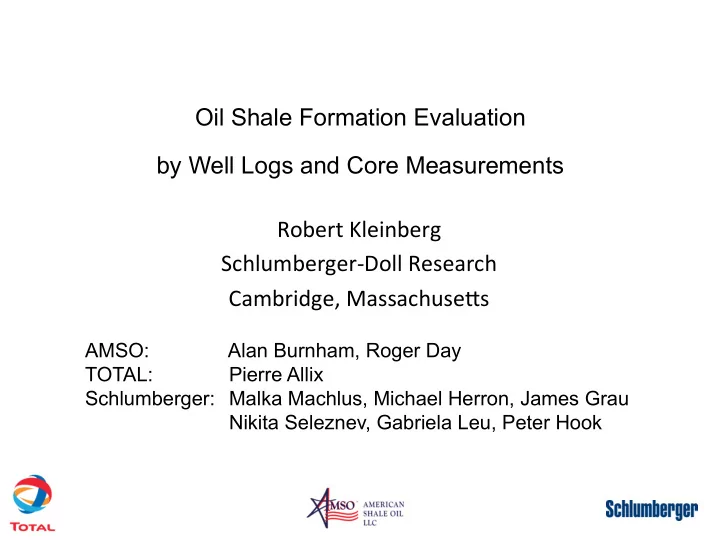

Oil Shale Formation Evaluation ¡ by Well Logs and Core Measurements ¡ ¡ Robert ¡Kleinberg ¡ Schlumberger-‑Doll ¡Research ¡ Cambridge, ¡Massachuse:s ¡ ¡ AMSO: Alan Burnham, Roger Day TOTAL: Pierre Allix Schlumberger: Malka Machlus, Michael Herron, James Grau Nikita Seleznev, Gabriela Leu, Peter Hook
Objectives of Oil Shale Well Logging ¡ Volumetrics – Density Porosity, Resistivity, Magnetic Resonance total mineral matter water kerogen Composition – Capture Spectroscopy common inorganic minerals (quartz, calcite, illite . . .) unusual inorganic minerals (dawsonite, nahcolite . . .) total organic carbon Geology - Microimager fractures vugs slumps
Oil Shale Well Log Montage ¡ 50 ft black=albite
Objectives of Oil Shale Well Logging ¡ Volumetrics – Density Porosity, Resistivity, Magnetic Resonance total mineral matter water (& salinity) kerogen Composition – Capture Spectroscopy common inorganic minerals (quartz, calcite, illite . . .) unusual inorganic minerals (dawsonite, nahcolite . . .) total organic carbon Geology - Microimager fractures vugs slumps
Gamma-Gamma Density Log ¡ Measures Sum of Water + Kerogen ¡ ρ −ρ ma b Density Porosity φ = = φ + φ D w k ρ −ρ ma f φ ρ = porosity measured by density tool = matrix (grain) density (~ 2.7 g/cc) ma D ρ = bulk (measured) density = volume fraction water φ b w ρ = “ fluid ” (water+kerogen) density (~1 g/cc) φ = volume fraction kerogen k f
Kerogen is Invisible to Magnetic Resonance ¡ Measurement Dead Time Magnetic Resonance Signal water kerogen 2 s 200 µ s Measurement Time
Kerogen Volume from Density & Magnetic Resonance Logs ¡ Density Magnetic Resonance (DMR) Method ρ −ρ ma b Density Porosity φ = = φ + φ D w k ρ −ρ ma f φ ρ = porosity measured by density tool = matrix (grain) density (~ 2.7 g/cc) ma D ρ = bulk (measured) density = volume fraction water φ b w ρ = “ fluid ” (water+kerogen) density (~1 g/cc) φ = volume fraction kerogen k f Magnetic Resonance Porosity φ = φ MR w φ = φ − φ k D MR
Density Porosity & Magnetic Resonance Porosity 0.6 0.6 bad hole masked Density Porosity 0.5 0.5 0.4 0.4 Porosity Porosity 0.3 0.3 Kerogen 0.2 0.2 0.1 0.1 NMR Porosity 0 0 2020 2040 2060 2080 2100 2120 xx00 xx20 xx40 xx60 xx80 x100 100 feet 100108-03b Depth (ft)
Well Log Kerogen Volume vs Core Fischer Assay ¡ Well Log Kerogen Volume (gal/ton) 80 80 Core Fischer Assay (gal/ton) Well Log Kerogen Volume Well Log Kerogen Volume (gal/ton) Core Measured Fischer Assay Core Fischer Assay (gal/ton) 60 60 40 40 20 20 0 0 1900 1950 2000 2050 2100 xx00 xx50 x100 x150 x200 xx00 xx50 x100 x150 x200 Depth (ft) 100829-11b Depth (ft)
0.4 Total ¡Organic ¡Ma:er ¡ as ¡frac>on ¡of ¡ore ¡weight ¡ ρ 0.3 k TOM ( ) = φ − φ D MR Total ¡Organic ¡Ma:er ¡ ρ b 0.2 gallons ¡of ¡oil ¡per ¡ton ¡of ¡ore ¡ FA [ TOM 0.019 199 ] = − ¡ 0.1 Synthe'c ¡Fuels ¡Data ¡Handbook ¡ Cameron ¡Engineers, ¡1975 ¡ Figure ¡29. ¡Organic ¡Ma:er ¡Content ¡ of ¡Green ¡River ¡Oil ¡Shales-‑ ¡ 0 20 60 40 0 ¡ Modified ¡Fischer ¡Assay ¡(gal/ton) ¡ ¡ ¡ ¡
Fischer Assay: Well Log vs Core ¡ 80 80 Well Log Fischer Assay Estimate (gal/ton) Fischer Assay (gal/ton) Well Log Fischer Assay Estimate Core Measured Fischer Assay Core Fischer Assay (gal/ton) 60 60 40 40 20 20 0 0 1900 1950 2000 2050 2100 xx00 xx50 x100 x150 x200 Depth (ft) 100829-12b Depth (ft)
Water Salinity from Resistivity & Magnetic Resonance ¡ fraction of pore 1 φ MR m n S R S R Archie ’ Law = = φ = space that is = φ w w D w t a D water filled ( a ~ 1, m ~ n ~ 2 ) 2 R R @ reservoir temperature T = φ w t MR ( 1.1192) − T 21.5 C + ° ⎡ ⎤ salinity(ppk) 7.976 R (T)10 C = ⋅ ⎢ w ⎥ 21.5 C ° + ° ⎣ ⎦ [R w ] = ohm-meters Schlumberger Log Interpretation Chart Gen-6 (2009)
Water Salinity Estimate from Geochemical Logging ¡ Assume all NaCl is in Pore Water 3 3 g(NaCl) g(dry ore) cm (dry ore) cm (rock) g(NaCl) Salinity = = 3 3 3 g(dry ore) g(water) cm (dry ore) cm (rock) cm (water) 1 FSAL DWNACL RHGA 1 PIGE WKER PIGE ( ) = ⋅ − −
Green River Formation ¡ Salinity Log ¡ 100 Low porosity – low resistivity spike Low porosity – low resistivity spike 80 60 40 20 100108-01 0 1400 feet Mud filtrate salinity = 8 ppk
No Communication Between Fresh & Saline Aquifers ¡ Green River Formation Salinity Log 100 Low porosity – low resistivity spike 80 60 40 20 100108-01 0 1400 feet Mud filtrate salinity = 8 ppk
Summary ¡ Important information about oil shale deposits can be obtained from the same tools used in conventional oil and gas reservoirs. These include measurements of formation density, magnetic resonance response, electrical resistivity, and capture spectroscopy. Kerogen responds as part of the pore space to density porosity tools, but is invisible to borehole magnetic resonance. Simple processing gives kerogen volume and an accurate, depth-continuous estimate of Fischer Assay. A salinity log results from comparing magnetic resonance to formation resistivity. Agreement with a capture spectroscopy estimate is fair.
( 1.1192) − T 21.5 C + ° ⎡ ⎤ salinity(ppk) 7.976 R (T)10 C [R w ] = ohm-meters = ⋅ ⎢ w ⎥ 21.5 C ° + ° ⎣ ⎦ Schlumberger Log Interpretation Chart Gen-6 (2009)
Recommend
More recommend